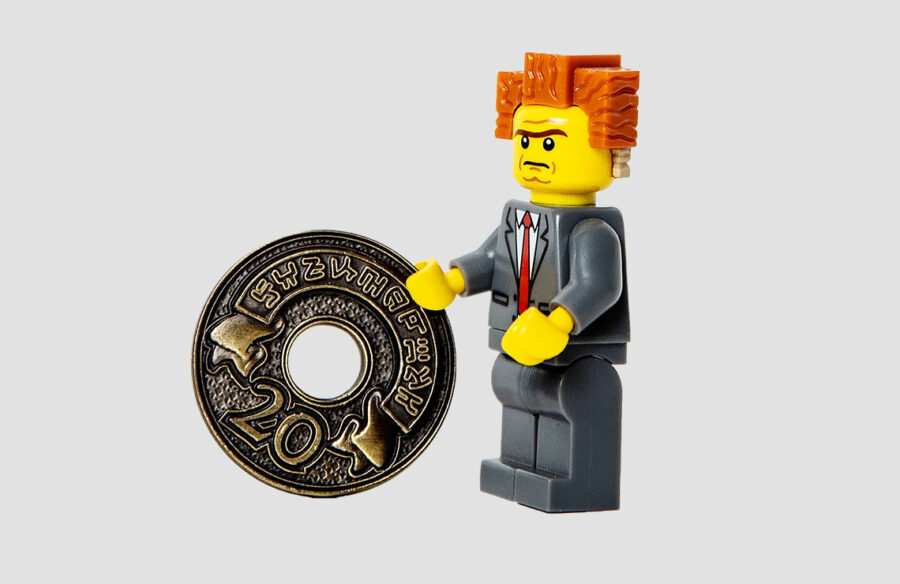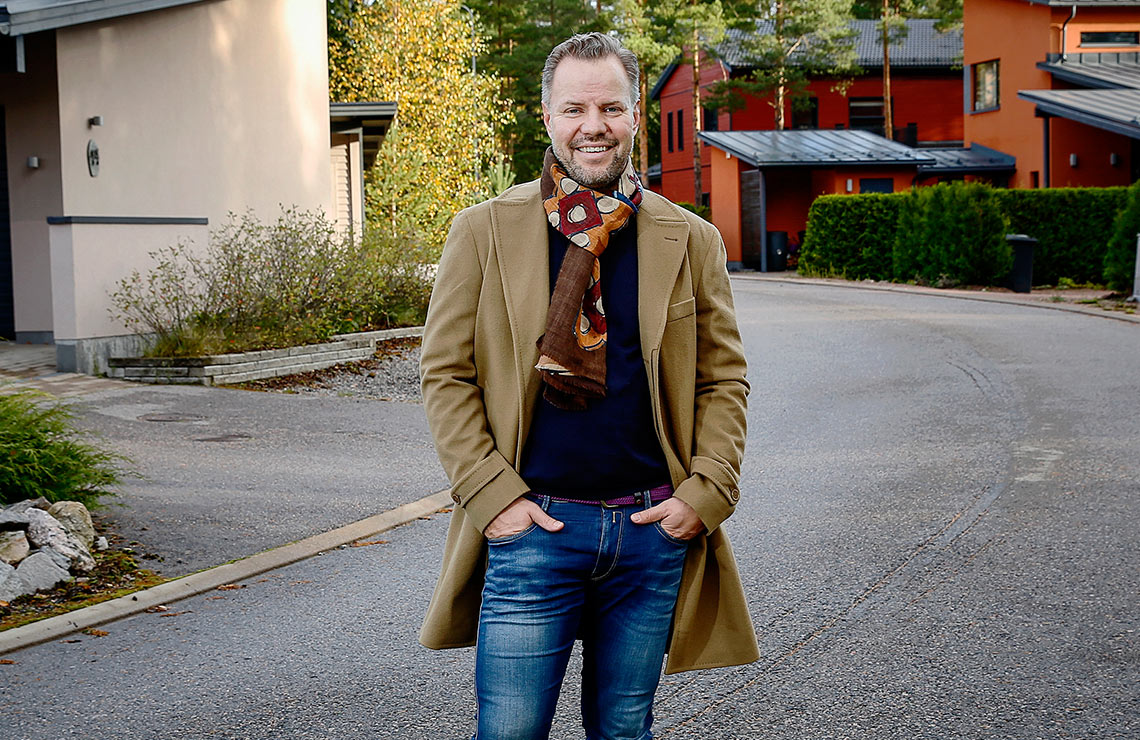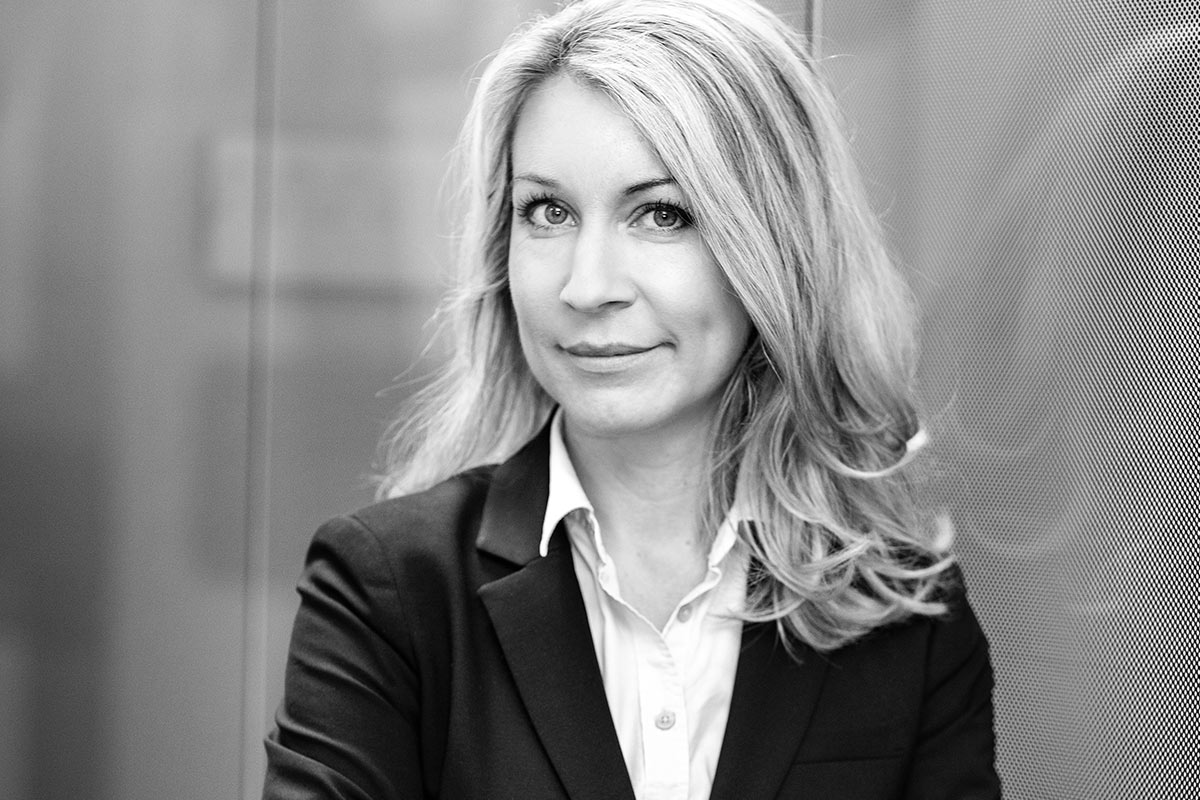It’s not about the ads any more

It’s not about the ads any more
20 years ago Schibsted challenged its own business by creating an online marketplace for classified ads. Now it’s time to take the next step. Next generation marketplaces will meet the users’ true needs.
Maria and Niclas are moving in together and have decided to rent out Niclas’ apartment on Södermalm in Stockholm. Listing it on Blocket is easy. But then it gets harder. Of all the people contacting them, who will be a good tenant? As first-time landlords, they choose Christer, a likable young man from Linköping. How could they possibly know that he would stop paying rent after four months?
Our online marketplaces are now more than 20 years old. During that time they have become an integral part of society. With more than 264 million visits per month, and unaided brand awareness in the range of 75 to 95 percent you’ll be hard-pressed to find someone who doesn’t know about Finn, Blocket, Tori or Oikotie. Sleek, modern apps have made it possible to post an ad in just seconds, while advanced search and recommendation algorithms have made it easier than ever to find what you’re after. Even so, Maria and Niclas found it stressful and burdensome to rent out their apartment. Why?

The reality is that even with all the advancements we’ve made over the last 20 years, we still owe our heritage to the old newspaper classifieds. They were essentially poster boards which left it up to the buyer and seller to figure out what to do after the initial contact. This is, unfortunately, still somewhat true today. It turns out that while making it easy to post and find ads is important, there are also plenty of other pain points buyers and sellers encounter, as the example with Maria and Niclas shows. In fact, if we zoom out a little, we begin to recognize that the goals of our users have nothing to do with ads at all. In fact, they are not interested in ads. What they really want is to rent out their apartment, drive a car, hire a dream candidate for a job or buy that one-of-a-kind set of vintage sneakers. Achieving these goals means overcoming a series of pain points in a longer transaction journey.
Different pain points
Next generation marketplaces will meet these needs and solve these pain points for consumers and professionals. While ads for different categories are fairly similar, the processes and pain points can be wildly different. For example, a landlord is interested in choosing the right tenant, having a solid contract in place and being certain that rent is paid every month. A car buyer will be concerned about the condition of the car, how to get a car loan, and how the payment is matched with the new ownership registration, among other things. Finally, a buyer of vintage clothing may be interested in shipment from a different part of the country. Each marketplace category has its own set of unique challenges to be solved in order to be called ”next generation”.
First and foremost, solving these pain points will make these services easier and safer. One example is Qasa, a fully digital real estate rental platform, which Schibsted is rolling out across the Nordics. Qasa has specialized in making the rental experience as convenient as possible. For the tenant it provides better search tools, such as making it possible to search within a specific commute time from where you work. The service revolves around a tenant profile which makes it easier for tenants to show who they are and for landlords to evaluate them. Finally, the service provides an added layer of security to the landlord by providing a digital contract, home insurance and payment guarantee.

Another example is within cars. Both Finn and Blocket have started the work to make the car sales process fully digital. This includes a digital contract, integrated payment and payout of car loans along with automatic ownership registration. There are also extra services, such as free insurance for 30 days to the new car owner. All these features are significant upgrades to our core service in order to meet the users’ needs.
Marketplaces will keep evolving
This digital process makes it much easier to sell your car yourself. Still, we know that some want it to be even easier and they are willing to pay for it. One indication of this is that more than half of all car sellers choose to trade in their car to a dealer, knowingly leaving tens of thousands of kroner on the table. This is where Nettbil can help out. With this service you just enter your license plate number and you get an immediate price indication. If you’re satisfied, you deliver the car to a certified test center. From here on everything is taken care of. The car is tested, pictures taken, and the car is put up for auction to thousands of car dealers across the country, ensuring that you get the best possible price for your car. You can literally sell your car in a day.
Some people will of course continue to just post an ad and do everything themselves, while others want a better and simpler service, and are willing to pay for it. Upgrading only a small percentage of our users to next generation marketplace models could have significant business potential – but not least it would also increase loyalty and meet the users’ core needs.
Looking into the future, marketplaces will continue to evolve rapidly in line with market demands. This evolution will make private-to-private transactions more similar to retail e-commerce experiences. For our couple, Maria and Niclas, life will be easier as they can rent out their apartment without worries, knowing that the service provided will ensure they get paid on time every month.

Christian Printzell Halvorsen
EVP Nordic Marketplaces/CEO of Finn
Years in Schibsted
11
What I’ve missed the most during the Corona crisis
The daily dose of fun and energy from physical interaction with colleagues
Fintech will keep changing banking

Fintech will keep changing banking
The financial services industry has been completely disrupted the last few years. What made this possible and what implications does it have on people’s personal wealth and society at-large?
The fintech landscape has changed dramatically over the course of the previous decade. Born out of the global financial crisis of the late aughts, a general distrust of traditional banks paved the way for a new wave of competitors, who utilized their technical superiority to reshape the financial services sector. Suddenly, your bank didn’t require a physical location, just an app. This caught the old guard by surprise, as they not only lacked the technological know-how to respond but were also limited by archaic legacy systems. Challenger banks arrived on the scene promising a user experience on par with the world’s leading tech companies – frictionless, modern, and on-demand.
Today the smartphone is at the forefront of banking, capable of making payments, receiving funds, and managing our financial portfolios. The words ”mobile-first” are not an aspiration but rather necessary for survival. Fintech has brought a new global standard of banking, from lifting emerging markets and helping to accelerate the adoption of e-commerce, to simplifying money transfers and expediting the end of physical currency. But where do we go from here? What does the future have in store for the next generation of fintech actors?

It’s difficult to assess how fintechs will evolve without knowing the full extent of Covid-19’s impact on the global economy. But let’s look at what the trends portend.
Going forward, expect big data to play a more prominent role in conjunction with developing AI technology. Risk assessment will take on a new shape as digital banks look to open up access to credit for new pools of customers. Whereas traditional banks relied largely on precedence when weighing credit risk, digital banks will have access to a much more nuanced, holistic, and accurate snapshot of an applicant’s creditworthiness.
AI will make banks more effecient
Real-time analysis of customer data (both financial and personal) will allow banks to cross- and up-sell products and solutions designed with the individual in mind. Advances in risk assessment will allow banks to reach the underbanked and consumer groups without a credit history. That’s why it’s important to pay close attention to artificial intelligence and its continued integration into financial technology. AI has the potential to make banks more efficient, allowing for cost-reducing automation while eliminating errors.
Look no further than insurtech companies, which have embraced AI and advanced analytics to help make more accurate risk assessments on random events like catastrophes, based on historical data.
At the consumer level, automation has the potential to oversee our financial portfolio and help guide us through complex decisions such as investments, retirement planning, and home loans, while also carrying out routine tasks such as bill payments.
According to Deloitte’s Bank of 2030 report, the ideal automated tool would operate behind the scenes, monitoring the market for deals and products without human intervention. Whether banks can deploy AI technologies at scale, however, remains to be seen.
Corona pushing new solutions
The pandemic in particular has been a boon for payment providers. Let’s start here in Sweden, where Klarna has skillfully navigated the crisis to become Europe’s most valuable fintech ($10.65bn). When the Coronavirus forced us out of stores and towards e-commerce, Klarna was there, with a well-designed product, simple USP, and custom payment options that quickly caught on with Millennials and Gen Z. Retailers rejoiced. After all, the easier a payment provider can take the customer from shopping cart to checkout, the higher the conversion rate for retailers.
But Klarna’s ambitions don’t end with payments. As Germany’s Handelsblatt notes, Klarna has grown to where it’s not just competing against other payment service providers such as Paypal, but has set its sights on banks themselves.
A host of other payment providers have thrived in a marketplace still marked by fragmentation. Dutch startup Mollie secured unicorn status (privately held with a valuation of more than $1bn) thanks to its application programming interface (API) that conceals the complexity for merchants of accepting localized payment options. One of Mollie’s lead investors in its most recent funding round referred to the company as aiming to be the ”Apple of the payments world.”
Globally, we’re at crossroads with regards to fintech. As McKinsey points out, many European fintechs are still not profitable and thus reliant on a scarce resource – investor funds. Yet fintechs have several inherent advantages – such as agility – and the changes they’ve brought about to the financial world are here to stay. Customers want more digital with their banking services, not less.
What we may end up seeing is a consolidation of power in the 2020s, with the largest banks and payment providers expanding their product offerings and portfolios with strategic acquisitions.
Or we could see the continued buildout of fintech ecosystems by global tech titans, in the search to create an all-in-one super banking app. In China, both Tencent and Alibaba have a duopoly on mobile payment platforms (Wechat Pay and Alipay), which when combined, according to CB Insights, serve nearly 94 percent of the Chinese population and act as a launch pad for other financial services, such as interest-free installment lending.
Amazon is creating a suite of services
One of the biggest hurdles for challenger banks is customer acquisition costs, an area where multinational conglomerates will hold a sizable advantage with their flywheel economic systems. This is the route Google and Amazon want to follow as they strategically move towards offering digital banking services. Amazon’s case study is particularly interesting, given the wealth of data it has on customers, from purchase history to entertainment consumption habits. Amazon is reportedly exploring forays into home insurance and medical insurance, to go along with a suite of financial services like banking, business loans, and payments. The question remains whether regulation will serve as a blocker, or merely an obstacle.
Let’s peek into the future. There are indications that the new decade should bring about a level of refinement when compared to the disruption of the previous ten years. Clearer hierarchies will establish themselves as the focus shifts more towards products and services, and less on direct competition with incumbent banks. That means, ideally, consumers should stand to benefit from a broader and more comprehensive world of financial opportunities.
Disruption is out with digital banks
While traditional banks and startup-challengers have begun to cooperate, the next market to be disrupted is insurance. And payment is on its way into a new phase with biometric security solutions. These are three major trends within fintech.
Disruption is out with digital banks
The first wave of challenger banks declared war on their traditional counterparts. But the newcomers on the market see the old guard less as adversaries and more as partners. Why? Because classic banks have leveled the playing field with the help of banking APIs – allowing for P2P payments. They’ve also introduced suites of digital services, and UX-friendly apps – and invested in in-house accelerators (see BBVA) to help develop future fintech partners. And while challenger banks are here for the long haul, especially given their impressive funding rounds in recent years, they still need to diversify their services to sustain revenue models beyond card transactions.
Insurtech
More than a few fintech analysts have identified insurance as the next multi-billion dollar industry ripe for disruption. The consulting firm McKinsey assessed that the combination of tech-savvy players on the market would ”alter the terrain on which incumbents compete.” This is particularly true among younger, forward-thinking consumers, who can compare different offerings (such as homeowner, risk, and even pet insurance) and discover transparent, custom-tailored products packaged via AI. Europe is an especially promising market for insurtech (thanks to a robust insurance culture), helping power Germany’s Wefox to unicorn status and attracting global players like Lemonade.
Payments
In recent years, payments have experienced more volatility and change than any other area of fintech. As the pandemic ushered in a new era of e-commerce, payment companies including Stripe and Klarna have seized the moment with their ability to manage what retailers have struggled with for over a decade: building a frictionless online payment system. This has also helped facilitate the growth of e-commerce in previously untapped markets.
The ”new normal” of the global economy means uncertainty, with unemployment and fluctuating wages, which is why we’re witnessing a rapid adoption of ”buy now, pay later” services, especially among younger consumers who might lack access to credit cards.
The need for more hygienic, contactless means of payment has also increased Western demand for virtual wallets and mobile point-of-sale terminals, the latter of which has big implications for Apple Pay and Alipay. Amazon took this one step further in September with its announcement of palm-recognition for payments. The use of biometric information is especially important to monitor, given how much security it offers.
Indicative of the rise of payments is how quickly the world’s two biggest payment providers (Visa and Mastercard) moved to acquire market space, particularly through strategic M&As and partnerships. However, the global payment infrastructure must address the issue of access, as a cashless economy will have significant impact on society’s unbanked.

Jeremy Cothran
Industry Editor, UpNext
Years in Schibsted
1
What I’ve missed the most during the Corona crisis
Hiking in South Tyrol, Italy
The ecosystem that nurtures giants

The ecosystem that nurtures giants
They are obsessed with customers’ needs, innovation and agility is crucial and they both compete and collaborate within. Companies working as market-oriented ecosystems have their own dynamic – and can grow into large dominators like Tencent, Amazon and Facebook. Here’s how it works.
We are living in an ever-changing and self-reinforcing cycle of technological development that continuously raises the bar for customer expectations. This in turn fuels the relentless forces that rapidly shape markets. From a macro perspective, this dynamic results in some interesting movements. We see a concentration of:
- Infrastructure providers that offer highly scalable and far-reaching networks that deliver standardized services.
- Aggregation platforms and marketplaces that enable connections among fragmented players.
- Agent businesses that serve as trusted advisors to consumers across the growing numbers of fragmented niche products and services companies.
As a large company, and especially if you are an incumbent in your current market, your likelihood for continued large-scale success relies on your ability to either become a dominant platform, infrastructure or trusted advisor company. If not, you should expect to be outperformed by smaller, faster and more innovative competitors empowered by the platforms.
Create and capture customer value
In an attempt to understand how some of our most successful companies have prospered in these hyper dynamic markets, we have, however, found another compelling path – to transform your company into a market-oriented ecosystem that thrives by being both highly explorative and scalable at the same time. Becoming a company that inhabits the previously incompatible strengths of both mature companies with a culture of exploitation and start-ups with a culture of exploration.
Market-oriented ecosystems’ ultimate purpose is to create and capture customer value. Typically, this is achieved by bringing together multiple players of different types and sizes in order to create, scale, and serve markets in ways that are beyond the capacity of any single player.

Ecosystems are empowered by enhanced and simplified connectivity that enables the participants to discover and develop new products, services and business models. Discoveries that would not be possible without the access to the full spectra of the ecosystem’s capabilities, especially the collective ability to learn, adapt, and innovate together. The sustained success from market-oriented ecosystems is achieved through both competition and collaboration. In some ways it is like a thriving bazaar where you both can compete with your neighbors’ shops but also collaborate to achieve your mutual goals.
Based on a common platform
Studies show that companies operating as market-oriented ecosystems thrive and consistently outperform other types of companies when competing in hyper-dynamic markets. The most famous examples include Tencent, Amazon, Supercell, Alibaba, Didi, Facebook, Google, Huawei and Haier, that together nurture some of the world’s most well-known brands.
The operating model of a market-oriented ecosystem is based on a common foundation or platform that all teams use and rely on in their daily work. This foundation consists of four components:
- External services: Purchased on demand from market leaders (cloud storage, productivity tools, etc.).
- Internal services: Aims to solve highly differentiated needs that cannot be solved by external services. These internal services are always operated by a dedicated and customer-centric team. Ideally no difference exists between operating a team that is focusing on an internal or external customer.
- Exchanges: Transactional systems that minimize barriers of cooperation that drive value creation within the ecosystem.
- Functions: Supports platforms, teams and functions on specific topics (HR, finance, legal, communications, marketing, etc.).
The key ingredients of the ecosystem are the teams that offer services and products to other teams within the ecosystem and/or to end users. Teams operate like small startups but have full autonomy to develop, prototype and test ideas with support from the entire ecosystem. Accountability is created by having clear, agreed upon objectives and measurable targets. As they fail or succeed, the teams are readily started, stopped, split or merged in order to maximize learning and success rate for the ecosystem as a whole. The accountability, clarity and flexibility make teams truly committed to achieving customer value by being close to the market and being able to quickly shift focus in changing market dynamics.
Leaders nurture culture
A relatively small leadership team exists with the main purpose of nurturing a common culture for the ecosystem, decrease barriers of cooperation by developing governance and to set a compelling vision and strategic priorities that align the ecosystem. Examples of governance mechanisms on which market-oriented ecosystem leaders outperform are performance accountability, idea generation, talent pipeline, information sharing and overall collaboration.
Over time as companies develop into market oriented ecosystems, they begin to exhibit four common essential capabilities: Outstanding external sensing with strong focus on market dynamics, an almost religious customer obsession with a relentless focus on solving customers’ jobs to be done, continuous innovation throughout the ecosystem, including an ability to always question the status quo, and finally agility everywhere that allows the whole company, even at a massive size, to quickly adapt to changing dynamics.
It is clear that companies that have been founded during during the digital era of the last two decades have a clear advantage when nurturing market-oriented ecosystems. However, there are examples of older companies and parts of larger companies that are transforming themselves into market-oriented ecosystems.
How do they do it? There are three key ingredients: establish a bold yet compelling long-term vision, transform step by step, and always act with a generous mindset. The journey will be long, revealing and tough, but the good part is that you will harvest the low hanging fruits along the way and find plenty of value while doing so.
Want to learn more about market-oriented ecosystems? We recommend two books that offer detailed introductions into the operating model: ”Reinventing the Organization” by Yeung and Ulrich (2019) and ”Future Legends” by Krings-Klebe, Heinz and Schreiner (2017).

Lotta Wollentz
Head of Strategy at Blocket
Years in Schibsted
4
What I’ve missed the most during the Corona crisis
Spontaneous micro updates and energy boosts from colleagues

Ian Vännman
Head of Strategy at Schibsted Next
Years in Schibsted
21
What I’ve missed the most during the Corona crisis
Serendipity – there are fewer random surprises when you spend
most of your time at home
Subscriptions drive new businesses

Subscriptions drive new businesses
Is the concept of ownership on its way to extinction? Subscription-based businesses have increased their revenues by more than 300 percent over the past seven years. Schibsted is looking into how to expand this model into new kinds of offerings.
I have to make a confession.
I binge.
If I find a new TV series I like, I could easily watch all the episodes of all the seasons in a matter of days. For me, imagining a world without Netflix – or similar subscription-based streaming services – is almost impossible. But such a world existed not too long ago.
Netflix was introduced to the Norwegian and Swedish markets in 2012, after having launched its streaming service in the US in 2007. In 2015, Netflix had grown to 70 million subscribers. Today, they have 167 million. When the new streaming service Disney+ launched on the American market last year, it amassed 10 million subscribers in just one day. Nine months later, it has grown to 60 million.

It is almost difficult to comprehend the massive growth subscription-based services have seen over the last few years. Internationally, more than seven out of ten consumers subscribe to one or more services, and the number is growing. The growth is largely driven by consumer demand; consumers want the convenience, flexibility and frequency that subscription models supply.
For businesses, the attractiveness of the subscription model is reflected in revenue growth. Subscription-based businesses have increased their revenues by more than 300 percent in the past seven years, significantly outperforming other companies. In the face of the Covid-19 pandemic, 76 percent of subscription-based companies saw a stable or even accelerated growth rate for their offerings. As a result, a growing number of industries and businesses are adopting the model.
Unparalleled growth in digital media
Schibsted has been in the subscription game for a long time, and we’ve seen unparalleled growth in digital media subscriptions over the last few years. As the Corona pandemic swept our countries, the hunger for news, information and entertainment drove our subscription numbers to new heights. As of October 2020, we have more than 840,000 digital subscribers across our Norwegian and Swedish brands. The appetite for digital news subscriptions has never been greater.
However, subscription is no longer a game that only media brands can play. Industries as diverse as mobility and home appliances are increasingly adopting subscription as a business model. Today, you can subscribe to products and services as diverse as a car, a dishwasher, and a unicorn-themed ”mystery box”. Whatever your niche is, there is a subscription-based product for you.
At Schibsted, we are following this widespread adoption of subscription-based models closely. Next, a division in Schibsted that invests in digital startups, is increasingly looking at and making investments in subscription-based services, including the podcasting platform Podme. In addition, our marketplace division is investigating a variety of subscription-related opportunities. We see that the subscription-related expertise and experience we have built up for years within our media division can be utilized in new ways, in very different parts of our organization. Our goal is no longer just to increase the number of media subscriptions we have – but to have more subscription-based business throughout Schibsted, and to deepen the relationships we have with subscribers today, by giving them subscriptions that offer them more and more relevant products, services and content. Being subscription-driven is about catering to genuine user needs and wants.

So, what do users want? Well, no matter the product or service, they will most likely prefer the option that is simple, convenient and easy to understand. Owning a product is often none of these things. In fact, product ownership is often a hassle. Owning something means that you have to pay up-front for a product that you do not know how many times you will actually use. Owning something might mean you have to pay for or spend time on the maintenance of that product. And in the age of rapid innovation and technological advances, owning something might also mean the inevitable frustration of watching your product become obsolete as new innovations enter the market.
We want access instead of owning
So, fundamentally, most of us very rarely actually want to own something – rather, we want access to what that product or service can offer us in value, right when we need it. Take washing machines as an example. Do you really need to own a washing machine? Or do you need your clothes to be clean, at a reasonable cost, with minimal effort?
Increasingly, research suggests that consumers favor ”access over ownership”, and 57 percent of adults worldwide say they wish they could own less ”stuff”. This trend is often known as ”the end of ownership”. And as ownership ends, so begins the era of usership – where the focus is on using and paying for what you need, rather than owning it. Just like with subscription-based products.
From a business perspective, the end of an era that has served business owners and shareholders well might seem intimidating. However, rather than being threatened by change, joint trends of usership and subscription could result in vast opportunities going forward for both Schibsted and others – within existing business, across businesses and within new product areas. By using our assets smarter and investing in the subscription economy, we believe we can secure existing business, create opportunities for future growth, and most importantly: cater to genuine user needs.

Hanne B Finstad
Head of Subscription Hub
Years in Schibsted
8
What I’ve missed the most during the Corona crisis
Hugs
Gen Z values journalism

Gen Z values journalism
Generation Z creates what they consume and consumes what they create. But, according to a report from Tinius Trust, their approach to news is different. When consuming digital information, peers content is replaced by the work of journalists.
There are many truths circulating about Generation Z. According to the news publication Quartz, they are concerned with the environment, sustainability and gender identity. They are the primary creators of the content they consume. They are online ”almost constantly” and social media binds them together globally. But the new report reveals that Generation Z in Norway and Sweden has habits that differ from global truths, when it comes to getting updated digitally.
64 percent of the report’s respondents in Norway and 53 percent in Sweden say that they go directly to national media to keep updated digitally. National media is the most popular source to keep updated in Norway, and the third most popular in Sweden. According to Reuters Institute, globally only 16 percent of those aged 18–24 prefer to start their digital search for news with a news website or app.
The report from Tinnius Trust is based on surveys conducted by the research company Norstat and it covers the digital information habits of Generation Z (born 1995 – 2005) in Norway and Sweden.
A relationship built on trust
The results indicate that the strong, direct relationship between Generation Z and the media is a result of trust. It shows that 73 percent of respondents in Norway and 54 percent in Sweden trust that news media or journalists provide trustworthy updates digitally. Furthermore, 74 percent in Norway and 64 percent in Sweden agree with the statement ”I like that information I find digitally is fact-checked by a journalist”.
The scores are a little lower in Sweden. Some Swedes seem skeptical of a one-angle approach to digital news. The report shows a 21-percentage-point gap between the respondents’ use of search engines in Norway and Sweden, making search the most popular source to keep updated in Sweden. The youngest group (aged 15–20) in Sweden use social media just as much as search (61 percent) and find blogs more useful (10 percent) than other respondents. They emphasize the value of receiving authentic stories directly from sources.
Strong media brands are valued by Generation Z. The report shows that 30 percent believe it is very important that news they consume digitally comes from a well-known brand. Still, they do not recognize specific journalists. When asked to name a journalist, blogger or person to trust when consuming digital information, journalist Fredrik Solvang is mentioned by 18 respondents in Norway, and blogger Therése Lindgren by 15 respondents in Sweden – these are the two most mentioned names by over a thousand respondents in each country.
Generation Z has never experienced a life without smartphones. They are used to having a number of options available digitally and so, it is no surprise that they also crave options when consuming information digitally.
English as an option
Language preferences are one such an example. In the report half of the respondents prefer their official language when they consume digital information. Still, 38 percent in Norway and 36 percent in Sweden don’t care whether the language is Norwegian, Swedish or English. When speaking to respondents in smaller focus groups, some argue that media should offer English articles to those who don’t speak the official language and ensure access to news for all.
Length is another example, although the shorter the better. 71 percent in Norway and 56 percent in Sweden agree with the statement ”I like that digital information is short and explained rapidly”. Yet, 36 percent in Norway and 35 percent in Sweden agree with the statement ”I like that digital information is thoroughly explained and takes time to consume”. In the focus groups some argue that media should write short summaries with the option to ”read more”.
The favorite format of the respondents in the Tinius Trust report is to read a text. However, 38 percent in Norway and 31 percent in Sweden prefer a combination of text, video and sound when they consume digital information. The youngest group (aged 15–20) is more positive towards the use of video. Only a few percent prefer a sound file or podcast.
Also, Generation Z is not so eager to interact digitally with news content. 77 percent in Norway and 65 percent in Sweden disagree with the statement
”I like to publish text, video or sound files based on information I find digitally”. 42 percent in Norway and 38 percent in Sweden disagree with the statement ”I enjoy to like, share or comment on information I find digitally”. In the focus groups, respondents say they prefer objective news. A 19-year old man says: ”If I look up information from a serious source and random persons could interfere and state their own opinions, it would disrupt the core of why I chose a serious source to begin with”.
The relationship between Generation Z and the media is largely run without a paid subscription. According to Reuters Institute, 19 percent of those aged 18–24 pay for digital news globally. The report shows that 15 percent in Sweden and 20 percent in Norway pay for digital news. More respondents pay for music, video/movies and games digitally today, than for digital news. In the future, news exceeds games. Twice as many, 34 percent in Sweden and 40 percent in Norway, believe they will pay for digital news in the future.
There is at least one new truth about Generation Z in Norway and Sweden that should be carried along into the future: they value journalism
Some respondents in the focus groups frequently argued that news is a right and consequently it must be free and available to all. Eight out of ten respondents who are not willing for pay for digital news say it is because they find digital information for free. A 17-year-old woman says: ”To pay for news is unnecessary. You will find the right information if something significant takes place, and that information will be available for everyone”. In the focus group they also underline that while news is everywhere, entertainment is offered exclusively to subscribers. So, if digital news becomes just as limited, these opinions may change. Based on the report from the Tinius Trust, there is at least one new truth about Generation Z in Norway and Sweden that should be carried along into the future: they value journalism. And now it’s up to media businesses to turn that belief into subscriptions.
The Tinius Trust is the majority owner of Schibsted. Read the full report at Tinius.com.

Hansine Korslien
Head of communications, the Tinius Trust
Years in Schibsted
?
What I’ve missed the most during the Corona crisis
Live theatre
Grab the readers’ hearts

Grab the readers’ hearts
It should be based on nearness, a deep understanding of society, and a talent for reacting quickly to what is important for people. Frøy Gudbrandsen at Bergens Tidende looks into tomorrow’s news journalism.
As I write this, it is only a few days after the city of Bergen was once again locked down because of a sharp increase in Covid-19 infections. It had spread from student parties to builders at the university, to several choirs, to a school, and to two more schools.
Practically every cultural event was cancelled. The theaters were just ready to set up their plays again. Now they were closed. The hotels had just recently called back the staff that had been laid off. Now they were being laid off again.
”Don’t be social”, was the message from the local authorities – a seemingly straightforward instruction but in reality, it means no jobs, and plenty of worries, fear, loneliness, chaos and lots of uncertainties.
The need to inform will not disappear
On days like this it is easy to envisage the future for the news media. We become important when a crisis hits. We do not know quite how we are going to distribute news in a few years’ time. Formats and platforms may be new, but the need for news media to inform, interpret, explain and help people to navigate, will hardly disappear. The larger the drama surrounding us is, the easier it is to see what our role should be.
A more demanding task is to see how we can remain important in people’s lives when the message on the banners is ”everything will be all right”. In periods when most things go well and the big, big issue is what we are having for dinner, that’s when the news media is less important. Well, of course we can exchange recipes but that is hardly why we are in this business.
A key to being a part of people’s lives, as a news medium, is nearness. We should be near those we are writing for. There has been a substantial change from gut-feeling-journalism to a journalism that is taking in what is important in people’s lives. But the transformation has only come halfway.

By nearness, I mean geographical nearness and physical presence where it happens; journalists who report what they see with their own eyes.
Nearness also means to be close to the actual behavior of the customer. We must understand people’s needs better. Explain things they are actually wondering about and interpret what they need to know. This can mean going out, talking to local people and being good at catching what is worrying, irritating and thrilling them.
If the social distancing during Corona times has taught us anything, it would be that human contact is invaluable. Also, in journalism something is lost as the distance between people grow.
Closeness means more
But it means more to have closeness to readers and to analyze data. This is the way for us to constantly learn more about what kind of journalism readers need in their lives and in what way news should be distributed in order to reach their target.
Sharp eyes and ears combined with solid and thorough analysis will give us that nearness.
It is also absolutely crucial to under-stand society and the slow drama that we live in, a drama that is transforming working life and everyday life for very many people: the green shift. Along the Norwegian west coast this is particularly dramatic. This is an area where oil dependency is strong, and it will come to an end in a few years. This will have consequences for the entire Norwegian economy as well as for the working life, but a few towns will be more violently hit. The green economy shall prevail but exactly what that means, nobody knows.
These changes develop slowly, resembling what we have seen in the pandemonium. But they are big changes that can shift powers.
We must inform, interpret and explain to help people navigate in complicated waters
Since climate policies mean big changes, they can be controversial and often polarizing. Both toll roads and wind power are examples of this in Norway.
If the news media is going to be important, we must do exactly what is so obvious to us in an acute, big news event. We must inform, interpret and explain to help people navigate in complicated waters. But precisely because there is such explosive power in the hottest news, those that affect people’s lives, that nearness is necessary.
In the end, it is necessary to be quick in a different sense than before. The news media probably has less influence in deciding what becomes the big debate. At best you could say that ordinary people have gained more power to influence the topic of major debates. But the most frightening of all is the prevalence of fake news and conspiracy theories, a constant threat against an enlightened, public debate.
Another threat to the role of news media in the public debate is the tempo. The public debate has become constantly unstable. To me it appears more unpredictable and shifting. Through social media, something that in the beginning looks like tiny protests takes on an exponential growth that can be difficult to predict – unless you are in tight contact with your readers.
A fact-based and balanced journalism
One example is the road toll debate. It went from being something in the margins to dominating the election debate in 2019. In Bergen the first opposition appeared in the transport business, when trucks blocked the streets in town.But a few months before the election a forceful resistance grew among much wider circles in the population, emanating from a citizens’ action on Facebook. The result was that a new political ticket had support from 16.7 percent of the voters in the Bergen election.
A year after the election, polls showed that the new listing had lost nearly all of its support.
As news media, our goal must be to understand, explain and to communicate what is happening. In the intense debate our role must be to stand for fact-based, balanced and critical journalism. But in order to take a relevant role as the engagement is exploding, we must take the position to serve as an important venue for debate.
So far, the problems with fake news have been smaller in our part of the world than in other countries. But it is hanging over us in the public debate as a constant threat. Articles from unserious media, that make only a small effort to communicate the actual truth, partly have a large amount of readers and get widely spread through social media. That is definitely a cause for worry.
Our response to these challenges is to be the place that the readers know they can go to for trustworthy news. It is as important that we succeed in this in everyday life as it is in a crisis.

Frøy Gudbrandsen
Editor in chief, Bergens Tidende
Years in Schibsted
8
What I’ve missed the most during the Corona crisis
Crowded concerts
A human voice behind the news makes all the difference

A human voice behind the news makes all the difference
The interest in and need for news has never been greater. At Aftonbladet the number of visitors has increased dramatically. Live reporting with option to interact and ask questions is a success – as is audio. Some 15 new podcasts are on their way.
The interest in news has skyrocketed during the pandemic. Most of us only need to look at our own behavior during the crisis to understand this need, but it’s also proven in a survey from the Swedish research company Ungdomsbarometern (approaching 15–49 year-olds). They report that half of the respondents spend more time on news sites during the pandemic than before. At Aftonbladet the number of visits and page views almost doubled when it all started. During the shocking days in mid-March, we reached almost five million unique visitors and 55 million page views every day. The behavior was the same for many weeks, and surveys tell us that the population has formed a stronger relationship with several news sources during the pandemic. There is a strong need to be updated and to get perspective on these complex events.
A strong urge to ask questions
Especially one type of new behavior has characterized this longtime, ongoing pandemic: the dialogue-based news reporting. As a part of Aftonbladet live reporting there is a 24/7 opportunity for the users to ask journalists questions. During the pandemic, the urge to do so has been stronger than ever. Since March 12, we have received over half a million questions from our readers, and our journalists have answered as many as possible. It has become very clear that people in many cases turn to news sources to get information rather than to the official authorities, which really emphasizes our societal mission.
The user experience, with a live feed that keeps you updated, live video and the possibility to ask your questions or to read what others have asked, has generated never-before-seen engagement and love from the users. This open line with the audience is a competitive advantage for us that really differentiates us from the big platforms.
In Aftonbladet there is that human touch, there is a person behind the news, always someone there who you can actually reach out to.
The engagement will continue
We believe that this engaging behavior will continue to grow in all types of news. This type of reporting is already available all the time in both Aftonbladet’s Supernytt and in the VG Nyhetsdøgnet. Here the conversation between the newsroom and the audience goes on day and night – peek in and have a look. Many times the questions are very entertaining!
Another trend that really reaches and engages our users is audio. And by that I’m not talking about the big buzz with ”hi Google, give me the latest news”-voice assistants that haven’t really taken off in the Nordics yet. I’m talking about podcasts. A medium that has been around for some time, but now really is accelerating with a 25 percent increase in weekly listening since 2018 (Orvesto). But still, only around 55 percent of the Swedish population are actually listening to podcasts and we know that there still is a big untapped market among the older segments.
That’s why Aftonbladet, in the coming months, will launch some 15 new podcasts – and a significant amount of them the users will pay for. This is a new strong trend in the market with Spotify (yes, it is a paid product, you have just probably forgotten you do pay) going in heavily on unique content, as well as the Schibsted-owned company Podme that builds its business model on paid pods.
A higher willingness to pay
At Aftonbladet we are already seeing a higher willingness to pay for online news and over a quarter of the Swedish population had access to paid online news in the last year. This and the fact that many users say they would pay for their favorite podcasts gives us a great opportunity to combine and strengthen our paid offering, Plus.
We had our first paid pod during the summer – Spring så snackar vi, a runners’ podcast. It’s a great example of users being ready to pay for niche content in the form of audio. Our upcoming launches will be in economy, sports, crime and news. For us the launch of our new podcast player within our own platforms has been an enabler for pods, and it also opens up an opportunity to introduce the world of pod to the 45 percent who have not yet left radio or discovered standalone podcast players on their mobile phones.
All in all, the trends mentioned above are all about finding new ways of engaging our users. Whether it’s about ”being there” to deliver information and answering questions in a live chat, or whether it’s about delivering podcasts that make the users dive into complex subject or just offering a short break from this complex time we live in.

Niclas Bergström
COO, Aftonbladet
Years in Schibsted
7
What I’ve missed the most during the Corona crisis
Being in the stadium supporting my beloved football team AIK
Meet our People

Meet our People
After almost five years in sunny Barcelona Jussi Lystimäki is back in Helsinki to win the marketplace arena in Finland for Schibsted.
”The timing is perfect for Finland”
”It has been damned hard, but now we have a strong position and I’m 100 percent sure that we will succeed.” No surprise, he loves challenges and complex situations. So far, they have mainly been connected to making acquisitions on remote – Schibsted has recently bought the Finnish marketplace Oikotie. But it’s also about building a new organization without actually meeting the people involved, but using remote meetings on video.
”I started off calling all communication people I knew to understand how to do this on video.” At the same time, it’s all familiar, Jussi used to be the CEO of Tori, but left for Barcelona to develop Schibsted’s international business. ”It’s always hard in a new country when you don’t know the language, you live in a rental, and you don’t really get to know people. You adapt but only now I realize that I am relaxed, for real.” So, why Finland now?
”The opportunity for Schibsted is perfect. In Finland the media houses own the marketplaces – but it’s their secondary business. And all the vertical positions are still open. Also, we thought the Corona crisis would be an obstacle when making the acquisition – turns out it was the opposite. Sanoma, like other media houses, needed to secure their main business and was eager to sell.”
Jussi Lystimäki
CEO, Schibsted Marketplaces Finland
Years in Schibsted: 10
What I have missed the most during Corona crises: I miss the buzz and good energy in the office.
Hygglo takes step by step to success
Which tool is the one users at Hygglo are most eager to get hold of quick and nearby?
Which tool is the one users at Hygglo are most eager to get hold of quick and nearby? A bolt cutter. This sign of desperation is not a significant pattern amongst most users though. And patience and an analytic mindset are more adequate words to describe the company and one of its founders, Ola Degerfors.
”In some sense, you might even call us boring.”
Ola founded the service that allows users to rent out things in 2016, together with Axel Hellström and Henrik Fräsén. Schibsted invested soon after. At the time the idea had already been tried in those early days of the sharing economy. ”But our timing was right, we have had the patience to not give up and we don’t make many mistakes.” Ola refers to the platform and how they analyze data and speak to a lot of users to make sure they make the Hygglo experience as smooth as possible. ”Our goal now is to be the first to prove this business profitable. And then we will take on Europe.” They will do this the Hygglo way – improving the platform even more, step by step.
Ola is sure that’s the key. ”Sustainabilty is a driver, but the user experience and conveniency is what will change people’s behavior.”
Ola Degerfors
CEO at Hygglo
Years in Schibsted: 4
What I have missed the most during the Corona crisis: My routines – I like everyday life, like going to the office.
SvD wants to measure engagement
How do you measure if your journalism is engaging? Media houses often struggle with qualitative metrics and to understand why their readers are leaving – once they do. At Svenska Dagbladet they have built a data model to follow and learn about this – supported by AI.
”We needed a compass, something that could indicate the level of engagement amongst our users”, says Gabrielle Lindesvärd, responsible for data and analysis at SvD.
It was key to build a model that was easy to use and easy for the organization to understand. So, Gabrielle and her team developed an internal simple tool, tried it out and iterated as they went along. ”We decided on a model which measures how often our users interact with our digital products. And it really works. When we for instance are launching a new product we instantly know if engagement is up – which means it was a good idea.” The project also got some extra help from two KTH students who built a churn model, based on machine learning and the engagement model. ”Thanks to this we got a lot of data, proving that our method is valid.”
Gabrielle Lindesvärd
Head of data & analytics, SvD
Years in Schibsted: 5
What I have missed the most during the Corona crisis: People overall and Babette’s stracciatella pizza.
Break them up

Break them up
Will the history of the Gilded Age repeat itself? When Big Tech has gone from good to evil, voices are raised to break the companies up.
Marshall McLuhan dreamt of a global village already in the 1960s, and boy did he get one. It all started out so well – The Internet was a church of connection, education, and democracy and its priests promised not to be evil. At the pinnacle of optimism, in the early 2010s, social media powered the democratic movement of the Arab Spring and Mark Zuckerberg opened up on primetime TV about his home, his relationship and a USD 100 million donation to charity. Today, the naïvety has been replaced with realism. Strong voices argue that we should Break Them Up, and Mark gives interviews in the Senate instead of at Oprah’s. Somewhere along the way left, right and center agreed that Big Tech was no longer a poster child for good, but a force of evil – a manipulator of elections, a dampener of free speech, and a threat to fair competition. Because competition and choice are good. Monopolies are bad. And if they happen anyways, Sherman will save the day.
Late republican senator John Sherman of Ohio that is, and his landmark federal competition law the Sherman Antitrust Act. A law that was passed by a unanimous House of Representatives in 1890 aiming to limit cartels and monopolies, and still today forms the basis for antitrust litigation by the United States government. Sherman himself said the purpose was to protect consumers:
“To protect the consumers by preventing arrangements designed, or which tend, to advance the cost of goods to the consumer.”
-John Sherman, 1890
The historical backdrop of this competition law was the Gilded Age – gold on the outside and something far less illustrious on the inside. Railroad and Oil barons built vast empires with monopolistic tendencies, and when challenged by lawmakers and politicians many deflected and denied the problem and obfuscated the ownership and governance structure of their empires behind complex layers of trusts. There they lay hidden from public view, but as the story goes the young attorney general David Watson in Ohio happened upon Standard Oil’s original trust deed in a book. The preface of the book read:
“This fragment of the great law of corporations is written to throw light upon a dark subject. During the past twelve months certain mysterious combinations of manufacturers in this country, called “Trusts”, have sprung into prominence. They have increased rapidly, and have excited the alarm of thinking men. Their movements and plan of organization are secret, and are known to but few.”
-William Cook, 1888
David Watson, also a Republican, filed for dissolution of Standard Oil under the Sherman Act, challenging another famous John: Standard Oil owner John D. Rockefeller. During the course of the lawsuit, and a sign of the times of the Gilded age, both Standard Oil operators and Republican party henchmen swung into action trying to stop the young Watson. On several occasions Watson was offered bribes, and in no uncertain terms was he reminded that Rockefeller was a significant Party donor.
Watson did not relent, and in 1892 the Ohio Supreme Court ruled that Standard Oil was controlled by the trusts. Standard Oil, like a hydra, rapidly dissolved the trust in a meeting presided by Rockefeller and reformed as a corporation of New Jersey. It was not until almost two decades later that the Sherman Act case of 1911 – Standard Oil Co. of New Jersey v. United States – truly broke up the company.
Have we now come full circle from Sherman and Rockefeller? Former Secretary of State Robert Reich certainly thinks so and blogged about how the combined wealth of Page, Brin, Facebook’s Mark Zuckerberg, and Amazon’s Jeff Bezos surpasses the bottom half of the American population:
“They are the leaders of a second Gilded Age. In this new Gilded Age, we need to respond to them as forcefully as we did to the monopolies of the first Gilded Age and break them up.”
-Robert Reich, 2019
On the center stage of antitrust and regulation stands presidential candidate and senator Elizabeth Warren, hitting the refrain of how Big Tech is stifling competition over the last few years. In early 2019 she turned the volume up to 11, laying out a regulatory plan to break up Big Tech, including Amazon, Google, Apple, and Facebook. Spreading her message, she turned to Facebook to advertise her plan among voters, because where else do you go these days? And in an astonishing turn of events, Senator Warren was first blocked by Facebook, and then received support by Republican senator Ted Cruz.
“First time I’ve ever retweeted @ewarren. But she’s right – Big Tech has way too much power to silence Free Speech. They shouldn’t be censoring Warren, or anybody else. A serious threat to our democracy.”
-Ted Cruz, 2019
Big Tech has historically been seen as supporters of the Democratic party, and senator Cruz’s line of attack, that Facebook is a monopoly of free speech, is perhaps not the same argument as senator Warren is making. But in their call to action, they stand united.
The mighty have fallen before: other notable cases filed under the Sherman Act include the breakup of American Tobacco in 1911 and the breakup of AT&T in 1982. Generally, the antitrust actions versus AT&T are seen among the most successful, first the settlement in 1956 allowing IBM to innovate on the transistor – perhaps laying the foundations of Silicon Valley – and later in 1982 in bringing competition to long distance telephony and innovation to mobile communication. The court ordered a breakup of Microsoft, but after an appeal to the Supreme Court the ruling was postponed.
But the first modern tech company under threat of breakup slipped away in United States v. Microsoft Corp. In 2000 the court first ruled that Microsoft’s behavior was indeed monopolistic and that their business conduct unlawfully attempted to squash competition from Apple, Netscape, Lotus Software, Linux and others. Later in 2000, the court ordered a breakup of Microsoft, but after an appeal to the Supreme Court from Microsoft, the ruling was postponed.
The suit was fought both in the courtroom and in the public arena, with many sides weighing in. One famous instance was the open letter from The Independent Institute published in the New York Times saying that:
“Antitrust is supposed to be about protecting consumers against higher prices and other consequences of monopoly power. […] However, consumers did not ask for these antitrust actions — rival business firms did. […] Increasingly, however, some firms have sought to handicap their rivals’ races by turning to government for protection.”
-The Independent Institute, 1999
Nobel economist Milton Friedman, famous for criticizing government intervention in almost all forms, also weighed in. In 1999 he wrote an essay outlining his belief that the antitrust case against Microsoft risked future technological progress. Is it really in the self-interest of Silicon Valley to set the government on Microsoft, Friedman asked himself.
“When I started in this business, as a believer in competition, I was a great supporter of antitrust laws; I thought enforcing them was one of the few desirable things that the government could do to promote more competition. But as I watched what actually happened, I saw that, instead of promoting competition, antitrust laws tended to do exactly the opposite.”
-Milton Friedman, 1999
Friedman worried, in part, that the human energy and money spent on lawsuits would be better spent on innovation and product development. The computer industry was moving so much faster than the legal process. So, who knew what the shape of the industry would be at the end of the suit? In part, Friedman worried that antitrust very quickly becomes regulation.
This line of criticism was not new, and already in 1967 Alan Greenspan, later to become Chairman of the Federal Reserve, was arguing the Sherman Act’s negative impact on innovation.
“No one will ever know what new products, processes, machines, and cost-saving mergers failed to come into existence, killed by the Sherman Act before they were born.” –
Alan Greenspan, 1967
Despite the publicity disaster for Microsoft executive Bill Gates, the case was famously ended in a settlement without breakup. Ironically, this was partially due to the presiding Judge Jackson himself playing the publicity game and giving interviews. The settlement was notably against the will of nine states, including the state of California, which thought the settlement but a slap on the wrist.
The case was also famous for using professors as expert witnesses from technology and business schools such as MIT and Stanford University. Does the name Stanford ring a bell? Founded by Gilded Age railroad magnate Leland Stanford in 1885 it played an important role in the growth of Silicon Valley. Stanford is the alma mater of Google founders Larry Page and Sergey Brin, LinkedIn founder Reed Hastings, and Tesla founder Elon Musk, and certainly seems at the epicenter of this wave of technology companies.
So, will Big Tech of today run the same Golgotha as Microsoft once did? Is antitrust and breaking up Big Tech now on the bipartisan agenda? Will we soon see a unanimous House of Congress taking the Sherman Act into the digital age? Unlikely perhaps, but the public opinion is without a doubt changing. Antitrust law professor Rebecca Allensworth at Vanderbilt concluded:
“Ten years ago, it was all about being champions of these companies. Now it’s very fashionable to hate on them.”
-Rebecca Allensworth, 2019
Why is the mood changing? On the side of market dominance, Google’s and Facebook’s capture of 70 percent of digital advertising dollars has raised eyebrows. When, in addition, Google and Amazon were caught or suspected of unfairly promoting their own products on top of search and listings, the surprise turned into a deep frown. On the side of privacy, Facebook has had numerous high profile fallouts such as the Cambridge Analytica scandal. And when Facebook executives were caught or suspected of Gilded age style handling of situation, the frown turned into outright anger. And fear. Fear that was amplified and weaponized on the very same social platforms.
“When Facebook users learned last spring that the company had compromised their privacy in its rush to expand, allowing access to the personal information of tens of millions of people to a political data firm linked to President Trump, Facebook sought to deflect blame and mask the extent of the problem.”
-Delay, Deny and Deflect: How Facebook’s Leaders Fought Through Crisis, New York Times, 2018
It is perhaps no surprise that the populist-in-chief has tweeted out his disdain for Amazon and Jeff Bezos.
When a society feels anxious, the regulatory apparatus kicks in. Both because it might be a highly relevant reaction from civil servants, and also because it is a popular and politically motivated response to how voters are feeling. It is perhaps no surprise that the populist-in-chief has tweeted out his disdain for Amazon and Jeff Bezos.
Futurist Amy Webb’s argues that regulation is more important than ever right now on the global arena, with GDPR in EU and that Senator Warren’s bold statements is part of the US election spin-up. The breakup is perhaps unlikely to go through, Amy Webb predicts in her trend report for 2019, but big tech companies will have to divert attention and funds.
In addition to cadres of lawyers and lobbyists hired by Big Tech, the political critics of antitrust and regulation are rapidly mobilizing. The angles of counterattack are partially along the same lines as Friedman and Greenspan, that regulation hampers innovation. And some commentators are claiming that the technical challenge in breaking out Instagram from Facebook are insurmountable, despite being run by some of the world’s smartest and most well-paid engineers.
There is also a new theme: Geopolitics and Chinese tech’s rise to the forefront. Alibaba, Tencent and Baidu are no longer playing second fiddle. Big Tech of the East will surely take advantage if Facebook, Google, and Apple face restrictions or even breakup. Former Google CEO Eric Schmidt is arguing that regulatory bias hurts American consumers and hands China a competitive advantage. Facebook’s COO Sheryl Sandberg is appealing to emotions on CNBC.
“While people are concerned with the size and power of tech companies, there’s also a concern in the United States with the size and power of Chinese companies, and the realization that these companies are not going to be broken up.”
-Sheryl Sandberg, 2019
Another appeal to basic emotions has come from team Break-Them-Up and Tim Berners-Lee, inventor of the World Wide Web. Without blaming Big Tech and the creators of the large platforms, he is still concluding:
“We demonstrated that the Web had failed instead of served humanity, as it was supposed to have done, and failed in many places. [The Web] has ended up producing—with no deliberate action of the people who designed the platform – a large-scale emergent phenomenon which is anti-human.”
-Tim Berners-Lee, 2018
On September 6th, 14 attorneys general launched a bipartisan antitrust investigation of Facebook, prioritizing the mishandling of personal data. On September 9th attorneys general for 50 states announced an antitrust investigation of Google focusing on its dominance in digital advertising.
In the EU “Google and Facebook Got Some Very Unwelcome News” (Bloomberg) when it was announced that Margrethe “Slayer of Big Tech” Vestager will continue as commissioner for antitrust and adds data protection to her portfolio to boot. Anti-human or not, it is clear that regulation and antitrust are rapidly rising to the top of the corporate agenda.

Dan Ouchterlony
SVP Schibsted Financial Services
Years in Schibsted
14
My dream job as a child
Spaceman
Time for responsibility

Time for responsibility
When our democracies are succumbing to the threat of digital manipulation, social networks should be held co-responsible for the spreading of lie campaigns, writes Einar Hålien. He is the co-author of a Schibsted report on how to handle these networks.
The social networks should be held co-responsible for the spreading of lie campaigns and instigations because our democracies are succumbing under the weight of digital manipulation writes Einar Hålien. He is the co-author of a report about the Schibsted view on how to handle these networks.
“Words and pictures are powerful weapons. Do not abuse them!” So it says in the end of the Be Careful charter, which are the 0wn ethical rules set up by the Norwegian media. If you transfer them to the global social networks you could say that they are distributing weapons for free to everybody who wants them but decline to shoulder any responsibility if someone gets hurt.
Would there have been a different president of the United States if millions of Americans had not been lied to and manipulated through social networks in 2016? Would there have been a majority in Great Britain for remaining in the EU?
Was the outcome in the Norwegian local elections this passed fall affected by manipulations? Nobody knows the answer to these questions but the mere fact that they are raised is detrimental to the trust in democracy and in the democratic institutions. Politicians and public servants are targeted in the campaign of lies and they have no efficient ways of defending themselves. In a worst case this leads to fewer people wishing to take on positions of trust and the public institutions are partly blocked.
The problems are described well by many but it is hard to find the good solution. One thing that makes this complicated is the necessity to balance a judicial and regulatory defense of democracy with an equally important need to protect the freedom of speech. In Schibsted we have evaluated possible solutions that are intended to create this balance – in the report “Ensuring Democracy and Freedom of Speech online – a need for a balanced regulation of social networks”.
A new cartegory
The social networks typically regard themselves as providers of tech without responsibility for the content that is carried by the network, just as the telecom companies are providing distribution through cable or satellite. On the other hand some people feel that a solution could be to regulate the networks in the same fashion as the media that are run by an editor.
We think that both solutions have their weaknesses and propose that the networks be regulated as a new category of actors in the field of mass communication.
The networks are offering more than a satellite or a cable, they are offering functionality for liking and sharing and using algorithms for steering the content in the network in the “right” direction based on enormous amounts of data about every single user. At the same time, they cannot be called publicists simply because their work is not publicistic work. The networks have not defined any societal responsibility. They don’t produce or edit content and they don’t run their businesses according to any common ethical rulebook.
The social networks have revolutionized people’s possibilities to communicate with each other and be a part of a community. They have also provided chances to speak to all those who are suppressed by authoritarian leaders. The value of this for the community is formidable and we must not regulate in such a way that these values are lost. It would for example totally ruin the core character of the social networks if we were to force them to seek advance clearance of everything that the users are posting.
The solution that we support and wish to prepare for is to make the networks remove unlawful content after such content has been reported. Germany has tried implementing this system but it does not seem to be very efficient. Today’s rules are interpreted to mean that one has only to act against the single concrete posting that has been reported. The networks feel no obligation to act against similar postings made by others. Those who for example want to instigate terror of course use this – and the sanctions have only a small effect. This “hole” in the regulations must be closed so that the obligation of the networks to remove illicit content is relevant for all postings with the same content. We also propose that there should be a rule saying that users that have already been exposed to the illicit material are informed that it has been removed and why.
Participator’s responsibility
In the spirit of the law we find it logical to give the networks a participator’s responsibility for spreading of illicit content that they haven’t produced themselves and that corporate fines are used in cases when the law has been broken.
Both the EU and countries such as France, Great Britain and Australia have come far with suggestions as to how networks should be regulated when it comes to the spreading of dangerous content. A weakness in a lot of this work is the effort to describe a new category of illicit content called “intentional disinformation”. The question is how to describe a specific “intention” and who is to decide what constitutes “disinformation”. In the hands of the wrong authority such laws can lead to a substantial limits to the freedom of speech, which is undesired by Norwegian standards. We have a President of the Unites States who uses the term “fake news” about every piece of news he doesn’t like. We can imagine a similar misuse of the term “disinformation”.
It shouldn’t be prohibited to lie, but what should be restricted is the spreading of lies that do a significant damage to democracy or democratic institutions, systematically and on a large scale.
As an alternative to creating new regulations in the field of freedom of speech with the aim of limiting the networks, we propose using the rules we already have in our penal code. Here we have a multitude of rules, all aiming at protecting free elections and the democratic institutions. The problem is that the networkers’ responsibility as regards these rules has not been defined and the rules have to a large extent been dormant.
Laws on a national level
In our view it is crucial that laws setting limits to the freedom of speech in the future are established and managed on a national level. I the EU countries, the laws setting limits to freedom of speech are varying a lot and any attempt to create a common set of laws will most probably be a negative experience for the most open and liberal countries. On the other hand, what the EU should do is to create an over-arching set of rules establishing networks as a new judicial category establishing the networks’ responsibility according to national laws in the field of free speech, demanding transparency, for example about the consequences of the way the algorithms are set up and demanding supervision of the set of laws through national control. Each individual country should go through its regulations on illicit statements and make appropriate adjustments in order to clarify the participating responsibility of the networks.
As for content from media run by editors and distributed by networks we suggest that the networks would free from responsibility and thus incapable of changing anything in such content. This is in line with the proposition in 2016 from Alliance of Independent Press Councils of Europe. The publishing enterprise is already regulated in law and the responsibility is clearly placed with an editor. Therefore, it does not make sense, and would weaken the trust in content from editor-managed media, if the networks were to alter the content that an editor had already taken responsibility for.
The Scandinavian countries are in the top of the league when it comes to freedom of speech and freedom of the press. This gives us a chance to be listened to internationally when these topics are on the agenda. But for this to happen, it is necessary for politicians and others with an interest in the management of societies to raise up and take part in the debate. The threat to fundamental values that is presently growing will not disappear by themselves.

Einar Hålien
Group Editor and Senior Public Policy Adviser
Years in Schibsted
22
My dream job as a child
Fireman
Tech empowers patients

Tech empowers patients
Healthcare is undergoing a revolution where we are moving towards a consumerization of healthcare, empowering patients to take control of their own health. This is one of the reasons why Schibsted Growth is paying closer attention to the area.
Healthcare is truly a subject that concerns all of us. We will all get sick, at some point, to some degree and we will all have to interact with the healthcare system to varying degrees throughout our entire lives.
Like many other sectors, healthcare is about to enter a period of rapid change. But compared to industries like the financial sector, where a digital transformation has been going on for the past 20 years, it started much later within healthcare. One could actually argue that healthtech is today where internet was back in the 90s. The past years, something has happened though. Demographic changes and increasing wealth have made the sector grow fast. Demand for healthcare is rising all over the world and as it is not very vulnerable to economic cycles, investors have started to invest more in this area lately.
Four major drivers
There are four major drivers of this rapid change: the government, the consumers, technology and competition.
- From a government perspective, with an ageing population and rising healthcare costs, it’s vital to decrease administrative time for doctors and nurses and automate whatever they can in order to reduce costs and make care processes more efficient.
- From a consumer perspective (in this case patients) we are used to having critical and high-quality services on demand in a digital world. So with changing consumer behavior in other industries, we start to demand the same digital savviness when it comes to care.
- New technology such as artificial intelligence, wearables etc. enables a new kind of care that is slowly starting to be incorporated into care-processes. In fact, Sweden and Norway, have been in the forefront when it comes to implementing new tech in healthcare and were two of the first countries to roll out e-recipes which has had a similar role for healthcare, to what BANK-ID has had for fintech. Without this, many of the new digital primary healthcare services would not exist. We have also been early adopters of electronical medical records, another necessary platform for digital health.
- Since larger industrial players haven’t managed to fully implement new technology in their care processes yet, there has been an opportunity for digital newcomers. Many start off from the patient perspective and have a strong focus on patient experience, this has truly challenged the traditional players way of providing care.
Technology most fundamental
Among these four drivers, technology plays the most fundamental role in the healthcare industry’s transition. In fact, some even argue that “In the coming decade, developers will have a greater impact on the future of healthcare than doctors”. There is no doubt that tech incumbent’s interest for the healthcare sector has increased rapidly the past years. Earlier this year Apple’s CEO Tim Cook stated that when looking back in a decade, he hopes that the area where Apple has made the biggest contribution will be health. Not communication, not entertainment, but health.
One of the most evident and profound changes is that power is shifting from healthcare providers to patients. New technology enables patients to track their pulse, blood sugar level, calories in a way they haven’t been able to do before which creates expert patients, meaning patient knowing more about their health than their doctors do. Consequently, we slowly see how healthcare is transforming to be organized around consumers, rather than around institutions. This trend is called patient empowerment and is the cornerstone of many of the new startups’ products andservices.
When patients start to control their own health, we are suddenly moving from a system that largely cares about sick people, to a system caring about the healthy. This is where the real paradigm shift is. Focus is shifting from treating people when they are already sick, to preserving the health of the healthy people before they get sick. When patients are empowered, they can track more, hopefully prevent illness and stay healthy.
Zooming in on the Nordics, there is an expansive startup environment within the area. In 2018 the number of healthcare investments outcompeted the number of fintech investments, both in terms of number of investments but also in terms of the actual value invested in the field. Most of these companies have a patient-centric approach and go for the consumer market. There have been numerous new care-on-demand services launched the past years that enables digital doctor visits and a sufficient amount of smart self-monitoring services, allowing patients to track their own health data.
Patients becoming consumers
When patients take control over their health, they start to interact with the health industry as consumers rather than as passive patients and make active healthcare choices. This changes the relationship between the doctor or nurse and the patient. We (as in the patients) have new kinds of expectations on what a good patient experience is, and we demand the same convenience and efficiency as we are offered in other service industries. This is something completely new for the industry, but not for Schibsted. We know consumers and know how to build and scale consumer service.
The healthcare space is huge and Schibsted has slowly been starting to map out where along the patient journey it makes most sense for us to invest. Obviously, the patient situation becomes more complex the sicker a patient is, and as we know consumers, it makes more sense for us to focus on the patient-centric services in a prevention stage. It’s less complex, and completely aligned with the new paradigm shift where focus is placed on preserving health, rather than treating the sickets patients.
This, together with the consumerization of healthcare, is where Schibsted’s opportunity appears – an opportunity to help people actively stay healthy.
Schibsted investments:
- AHUM is a psychotherapy service where patients and therapies can meet.
- Hjemmelegene is a platform that enables doctor home visits
- Add Health Media consist of one media business and one investment business. Their media business consists of health portals such as Doktorn.com and in their investment business, they invest super early, (almost pre-launch) in various healthcare startups.
Thorough Add Health Media Schibsted has invested in:
- Symbiome is a gut health startup, analyzing the balance of bacteria in your gut. Symbiome have just completed their pilot and have planned to launch later this.
- Belly Balance is a FemTech startup which has a service used for people with IBS – stomach issues. Femtech is tech companies focusing on women’s health market.

Kajsa Gatenbeck
Investment Manager, Schibsted Growth
Years in Schibsted
2
My dream job as a child
Professional freestyle skier
Your stupid brain is the biggest risk

Your stupid brain is the biggest risk
Sabotage, intelligence attack or influencing – there are several kinds of cyber threats that can clog your business. Turns out we ourselves often are the ones opening the door for the hackers.
Imagine that you are an IT administrator and you are watching your screen go black. Just like that, out of the blue. You are silently cursing and start looking around. The same is happening everywhere. One after the other the screens go black. Some of them display a message asking for ransom money. The company is under attack and there is nothing you can do. Two years ago, that is what happened to the giant Danish company Maersk. The company has 80.000 employees and is presently number 262 on Forbes’ list of the world’s wealthiest companies. I don’t know, but I am guessing that Maersk had a state-of-the-art security system.
As a Norwegian journalist, I always read the yearly threat assessment report from the Police and the Intelligence service.
Both of them have for many years pointed at foreign intelligence gathering and cyber attacks as one of the biggest threats to national security and to Norwegian values. They are not talking about any homogenous group. Some of them can be business operatives wanting to get their hands on industrial secrets. Others can be uncouth criminals who are after credit card information or are extortionists. Still others can be intelligence officers ferreting around trying to find state secrets or mapping critical infrastructure. Or talented kids who are into “general motherfuckery”.
However, if the men behind the scene are a motley crew, it is still possible to sort what they are doing into three different categories.
Intelligence
Intelligence is in a way the low threshold activity. Foreign powers or business people find their way into servers and networks in order to spy. The aim can be to map and collect information about the defense and preparedness sector, government, business, research or crucial infrastructure. Intelligence gathering is something everybody is doing, but it shouldn’t be taken lightly. It can simply be the first stage in a three-stage rocket. The next stage is influencing maneuvers – and, if worse comes to worse – sabotage.
Influencing
Influencing is super trendy! Public and private actors make decisions that affect the interests of other countries or businesses. It is therefore useful to be able to influence these decisions. One can, as an example, imagine that the very large Maersk shipping network could be of interest for a builder of ports. Or that one major power or another have an interest in destabilizing and create divisions in Great Britain, just to take an absolutely wild example.
You have probably read an endless number of articles about this. The Cambridge Analytical scandal is an example. On order from Steve Bannon the company took advantage of a loophole in Facebook’s rules and used an inconspicuous app to gather user data from around 50 million users. These data were then used to influence voters in the American Presidential elections in 2016. Cambridge Analytica was also involved in the “Leave EU” campaign ahead of the Brexit referendum in Great Britain.
The Russian influencing actions directed at USA, EU and NATO are well-known. The somewhat unpleasant development is that China, that has traditionally been spying but not influencing, is cooperating more tightly with Russia and have probably become more active also in this field. The Australian parliament and parties, to mention one example, were recently hacked, just before a general election, probably by Chinese authorities.
Sabotage
Foreign powers and/or business actors plant complex encrypted virus hitting commercial activities or crucial infrastructure in society. That is what happened to Maersk. If that was a deliberate action to target Maersk, I really don’t know. Many signs point to it being a random incident. At Maersk it was the malware NotPetya that blocked the whole business. It could have been intended to be a Russian attack on Belarus activities, but went astray and ended up blocking 50.000 end points in 130 nations.
The only good thing one can say about targeted sabotage is that it is not very frequent. When directed at an enterprise, sabotage can prove costly, when directed at a society it can be categorized as an act of war. But there is a high risk of sabotage becoming more common in the future. In the last years digital sabotage has been tested in operations against European countries. Furthermore, the tools needed for sabotage have become cheaper and better so that smaller entities can be a serious threat as well.
Just watch out.
So … how to protect oneself?
Well, if you run a business, public or private, you should build a wall, to use a worn-out political phrase. You must upgrade your hardware and ensure that everything is updated. You cannot get around this. The problem is that it is not enough. You can have the safest data system in the world but still be letting intruders in.
Recently, I read a report from the data security company Proofpoint. They have found that the trend in the last two years has shifted from ransom money virus to espionage and theft of information. Because information and data are valuable stuff. The data that they find can both mean income and preparation for future attacks: And the most interesting thing about this is perhaps this: No intrusion or attack is being blamed on system error.
What is lacking in many companies is a security culture. Maybe the Head of IT shouldn’t have sole responsibility for security. Maybe the Head of HR should be on the track. Maybe all employees should be trained and be told that technology cannot always cover for them and be informed that they themselves are a considerable safety risk.
Proofpoint claims that 99 percent of the successful attacks are blamed on one employee or other who has been clicking thoughtlessly on an attachment, added sensitive information to a page on the net that looked trustworthy or has given away a password to someone who looked friendly.
The big, big majority of attacks are directed at man and man’s nature. Because the machines and the security systems are only one part of it, human beings the other. So, in the end there is one risk that is bigger than all the others: My stupid brain.

Joacim Lund
Technology commentator, Aftenposten
Years in Schibsted
14
My dream job as a child
Musician
A new look to bring our story out

A new look to bring our story out
Schibsted’s story began in the 1830s when a Norwegian printer lost a costumer – and started a newspaper. Today Schibsted is an international family of leading media brands, sustainable marketplaces and smart digital services with more than 40 brands and 780 million visits each month. Now it’s time to take on a role as a more visible actor in society – with the support of a new visual profile.
The story began with a challenge turned into an opportunity. When Christian Schibsted lost an important customer in his printing office he founded a newspaper. In 1861 the paper was renamed Aftenposten – which has since been a leading Norwegian newspaper. When he stepped into the news business, Christian Schibsted made a decision that today affects more than 5 000 employees.
Leading news brands like VG in Norway, Aftonbladet and Svenska Dagbladet in Sweden are now part of the Schibsted family, as are the marketplaces Finn in Norway, Blocket in Sweden and Tori in Finland. Not to mention a range of digital consumer brands focusing on empowering consumers and making peoples’ everyday life easier. Brands like Lendo, Compricer, Bynk and Kundkraft are just a few examples.
In many ways, the beginning of Schibsted has shaped the company. Schibsted is a lot about taking on challenges and finding new opportunities. Not least when news went online, and today when new competitors are playing by new rules. Curiosity and innovation have always been a key to success, as has the ambition to understand peoples’ needs and develop ideas and products with the help of new technology.
And not least – in Schibsted we are always asking ourselves how we can contribute to a sustainable and democratic future.
Just like Christian Schibsted did when he moved into the newspaper business. This was also a statement – standing up for democracy and freedom of speech.
The legacy of two entrepreneurs
In 1878 Christian Schibsted bought a building in Akersgata 51 in central Oslo where Aftenposten stayed until 2003. Just across the street, in number 55, both Aftenposten and Verdens Gang have their newsrooms today. VG is a member of the Schibsted family since 1966 and today the largest paper in Norway with 2,4 million daily readers. Its story is a drama in itself – founded by war heroes in the summer of 1945, it’s the paper that united Norway.
In Stockholm Christian Schibsted had a counterpart in Lars Johan Hierta. He was also an entrepreneur, fighting for democracy and freedom of speech. He founded Aftonbladet in 1830 and had to renew the license to publish the paper several times when the King tried to shut it down. Today Aftonbladet is the largest paper in Sweden – reaching almost four million users every day – and a digital pioneer, creating aftonbladet.se already in 1994.
It took a while before the legacies of the two entrepreneurs, Schibsted and Hierta, came together, but in 1996 Schibsted bought Aftonbladet. Today the newsroom is located in the Schibsted building in central Stockholm, together with Svenska Dagbladet, bought by Schibsted in 1998. When the Swedish papers joined, the family had already grown through a collaboration with the Norwegian regional papers Bergens Tidende, Stavanger Aftenblad and Fædrelandsvennen (the latter sold in September 2019).
The Stockholm building also contains the next chapters of the Schibsted story: the marketplace Blocket and a range of digital startup companies. The marketplace era started with the ambition to rethink media business. When classified ads went online to other competitors than the Schibsted newspapers, a new Schibsted company was founded – the Norwegian marketplace finn.no.
“The idea was not that well received in the advertising organizations since we were competing with our own newspapers. But the management knew something had to be done”, says Terje Seljeset, who led the Finn-project, launched in year 2000.
Today every Norwegian spends 21 hours at the site every year, on average. To win the Swedish classified market Schibsted bought Blocket in 2003 – and then the export began.
“We actually had the Blocket code on DVD-discs and left for Paris”.
Martin Frey, former CEO of Blocket was there when the international export of Schibsted marketplaces started. In a small room in the back of the newsroom of 20 minutes in Paris (which Schibsted then owned) Martin, a few colleagues from Blocket and a French team set up what was to become a French national icon – the marketplace Leboncoin, launched in 2006. France, and a similar site in Spain, was only the beginning, marketplace clones in Europe, Asia and South America soon followed, at the most Schibsted owned marketplaces in more than 20 countries.
Today the Nordic marketplaces Finn, Blocket and Tori are still part of Schibsted, while the other marketplaces have been spun off into the multinational marketplace company Adevinta. The split was carried out to make the best out of the two different companies, but there is still a strong connection – Schibsted is the majority owner of Adevinta.
Investing in startups
There’s also another story starting with Blocket – the lookout for innovative digital services and startups. Schibsted Growth invests in and supports innovative companies that address challenges we have in our day-to-day lives. The Growth team help founders and teams establish their products and scale their business and the portfolio includes companies like Lendo, Prisjakt, Kundkraft, Let’s Deal, Hypoteket and Ahum, all together more than 40 brands. Lendo is the largest, growing fast, with operations in Sweden, Norway, Denmark, Finland, Austria and Poland. The service compares fees and interest rates from different banks to give the customers the best alternative.
“Through Schibsted we can continue to find new potential business fields. We still control the company but have chosen Schibsted as our investor to get across to great input and network”, says Carl-Johan Nordquist, one of the founders of Hypoteket.
Their idea is to offer competitive mortgages.
Schibsted Growth is part of a division called Schibsted Next which also has a team that is rethinking media. They experiment, analyze and develop new independent products to complement and strengthen Schibsted’s core media business.
All of these brands within media, marketplace and digital services have always been the heroes in the Schibsted story starting with Aftenposten. They are the ones providing products and services that the end users use and relate to. But at the same time things are changing. Today social media giants are new tough competitors and the need to cooperate and have a strong common foundation within a company like Schibsted is crucial – and a great opportunity. We also want to be clear about what Schibsted stands for and carry on the heritage from Christian Schibsted. That’s why we will build the Schibsted brand both internally and externally even stronger, so that it will become more visible.
To do so we have a new visual profile. A new logotype that is a wordmark – the full company name – is of course a center piece in this identity. The dots in the logo’s capital ”S” also contains the concept behind the design – ”a unifying force”. The visual profile also consists of a new symbol, new brand colors, new fonts and more. All tools to get the Schibsted story out.
So, the heritage from Christian Schibsted is very much alive. In Schibsted we are entrepreneurs with the wish to empower people in their daily lives, to support them to make sustainable choices – and to always deliver trustworthy news, a foundation for our democratic society.

Ann Axelsson
Senior Project Manager and Editor of Future Report
Years in Schibsted
21
My dream job as a child
Veterinarian
Make it happen inhouse

Make it happen inhouse
How do you foster innovation? Schibsted Next Media is looking into new media products and is dependent on new ideas. Frida Kvarnström explains how her team works to reach successful internal innovation.
Innovation – a word on every business leader’s lips nowadays. The new ever-changing landscape with more dynamic competition than ever is driven by two self-enforcing trends; the customer’s continuously evolving demands and expectations that go hand-in-hand with the technological developments driving them. Companies, no matter the size nor the industry, need to innovate in order to remain relevant.
Businesses have different approaches on how to foster innovation. Some focus on venture investment and mergers and acquisitions, others team up with external innovation consultants to find the next big thing. But more often than not, the next idea already exists within the company and the people working there.
Willingness to embrace change
For a company to drive successful internal innovation and spark ideas some things need to be in place. The employees need to feel innovation can happen naturally. They require room and confidence to drive innovation, to challenge the existing ways of doing things and need patient leaders with a willingness to embrace change. The great thing with ideas is that they are cheap to come by, but worth little unless you execute on them. Companies often struggle to prioritize short-term versus long-term initiatives and close to core versus the next-generation business. This can lead to long-term value ideas or far from core business not getting the necessary focus and resources. The company needs to be strategic in how it allocates its investments, otherwise short-term investments tend to be over-prioritized, which can lead to long-term stagnation. Also, the further from the existing core business the idea is, the more separation it needs to flourish and to avoid being consumed by the core initiatives.
Experimentation, collaboration, failures, and learnings also come with big responsibilities, requiring a clear strategy and well-defined processes. To mitigate risk and reduce ambiguity you need to determine a few ground rules: how will we work, and what do we want to achieve?
Here are some suggestions on what you and your team can do to get started with innovation, but also what to be aware of:
Be curious and collaborate. New perspectives, knowledge, and insights are foundations for innovation. Meet and interact with people you know. Strike up a conversation with people you don’t. Listen to their thoughts and everyday problems. Be transparent and share your thoughts and ideas with others. Keep an open mind. Accept input and listen to questions. Read books, newsletters, and reports. Listen to a podcast. Visit meet-ups to broaden your view and expand your knowledge base. But remain disciplined and put some constraints on yourself. Otherwise, you might end up never getting started because there’s always someone new you could meet or a report you could read.
Dig deeper
Interact with your customers. If you have an idea of who you are targeting with your innovation, talk to people in that group. Don’t just ask them what they want, that will usually end up with them requesting new features and design. Dig deeper to understand their everyday pains. Observe them. Figure out how they behave when they use your or similar products today. Define some hypotheses beforehand but don’t force your truths on them. Have an open mind and let them lead the conversation. Be aware that your world view might limit your openness, refrain from being judgemental.
Don’t be afraid of failure and resistance. Innovation is hard work and the fear of failure mindset is a creativity killer. No one ever said it’s easy to build a flourishing company. You’ll face questions. You’ll pivot multiple times. Step out of your role and try to see your initiative from your skeptics’ lenses and use their input as fuel to answer their questions. It’s important to also remain humble and know when to stop, kill your project, and fail productively. A productive failure brings valuable insights and knowledge to your organization relative to the cost.
Innovation is a habit which you need to practice in order to improve. As a company, you have to build a culture of curiosity in order to drive internal innovation and be clear about whether an idea has to bring value in the short- or long-term. As an employee, knowledge comes with new ways of thinking and so does interacting and listening to your customers’ needs. Neither organizations nor employees should be afraid of failure and trying things out, as long as it is done in a disciplined way that celebrates learnings. The world around you will keep on changing – it is up to you and your organization to establish a foundation to enable you to change with it.

Frida Kvarnström
Head of Next Media
Years in Schibsted
9
My dream job as a child
Sports commentator
Meet our people

Meet our people
Lendo is the most rapidly growing brand in the Schibsted portfolio, launched in three markets in 2019. It all started in Sweden 12 years ago. Now the service that helps customers find the best loan is also established in Norway, Finland, Denmark, Poland and Austria – and in Spain from the first part of 2020.
No doubt, the focus is to grow and export the Lendo brand – perhaps it will be the next Blocket – whose concept has been launched in more than 20 countries all over the world. Having this experience within Schibsted is of course of great help when planning for Lendo’s future, Mikaela Grännby, responsible for the European expansion says. Deciding which countries to get into is a thorough process, she explains. The team goes through several steps where they investigate the size of the market, number of consumer loans, legal boundaries, digital maturity, banks and other partners.
“Poland is, for instance, very exciting with large growth and an established system of physical brokers – and not least, they are becoming more digitalized.”
Today the whole Lendo team consists of 140 people, 85 of them in Sweden.
When entering a new country, Mikaela and her team have to start from scratch – she describes it like starting with a blank sheet. But the Scandinavian heritage and being part of Schibsted, is of help and in Austria, Willhaben – a former Schibsted marketplace, now part of Adevinta – has been a door opener. The most interesting, and sometimes surprising, challenges have been cultural issues.
“I see it as a mission to export the Scandinavian working culture. The foreign teams I work with think we are nice, and I like nice teams. They allow you make mistakes and learn from them.”

Years in Schibsted: 15 My dream job as a child: Carpenter
Success for digital subscriptions
In Bergens Tidene digital subscribtions have become a success story. In four years, the total number of subscribers has increased by 30 percent. “Four years ago our prospects were not good. With several years of losing customers’ hopes were low. Now it’s completely different,” says editor-inchief Øyulf Hjertenes.
The recent success is built on three different digital offers: Basic, Premium and a family offer for four users, all with the idea of creating more value. Since the launch in January 2019, BT now has 12,000 subscribers to the Premium offer, which includes access to all news on bt.no and to a digital archive, crosswords, sudoku and more.
“The result is much better than we had expected. And even if the price is rather high, we know we can grow even more.”
The concept has been developed together with Schibsted’s other regional newspapers and is only the beginning of a strategy to secure that they all are financially and journalistically sustainable on a long term.
“Being a part of an ambitious media company like Schibsted, with access to product development and so many competent

Years in Schibsted: Schibsted invested in Dicopay 2019 My dream job as a child: Ballerina or architect
Dicopay makes it easy to get payed
Dicopay’s mission is to make it super easy for small businesses in the service sector to get paid. With the app and a few clicks, they can invoice directly when they have finished a job.
“The most common feedback we get is that our users think they’ve done something wrong – because it was so easy to get paid using our app,” says Marie Lundberg, CEO.
To Marie the service is almost a hygiene factor in our digital society. “Think about it, so many things are so easy to buy and pay for today online and with your phone. Why should it take a month before the bill from your painter arrives? And why should companies within the service sector have to wait until they get paid?”
Dicopay is a young startup company that Schibsted Growth recently has invested in. Marie says that the support from the Growth team is very important.
“We are fortunate to get help from experienced experts. At the moment we’re learning more about digital marketing, analytics and digital advertising.” Marie knows exactly what she enjoys most with her job: “Being able to solve a very obvious problem.”

Years in Schibsted: 0.5 My dream job as a child: Actually – to do what I do now.
“We make sure experts are up to date”
Since a few years back, Schibsted has a Public Policy team, which is working to inform and influence politicians and experts on issues that are important for our different operations. Rebecka Wulfing joined the team in May 2019.
“What I like most about the job is that I get to process issues which in the end have a positive impact on people’s lives.”
The team works with stakeholders in Norway, Sweden and on EU level to become a discussion partner and contribute with information and knowledge on how laws and regulations affect our businesses. The latest project is a report about social networks (read all about it on pages 76–77).
“In Sweden the knowledge about how these networks are affecting news publishing and digital markets is low. We want to make sure that the people who make the decisions are up to date.” That is a challenge, since implementing a new law is a long process, on EU level it takes seven years.
“The legislation we are working on decides the terms for our businesses. So we’re doing this to protect independent journalism and a sustainable development for new technology – fundamental pillars in a democratic society.”

